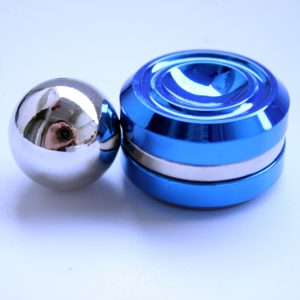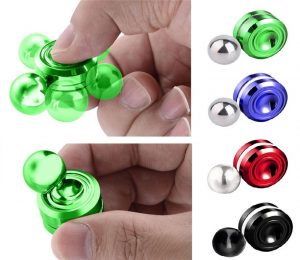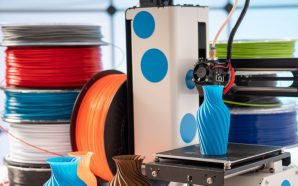The Orbiter’s concept was originally released in March 2017 by TEC Accessories on Indiegogo and they started delivering this in September 2017 (just last month). It has enjoyed a meteoric rise since it’s release. We think someone just came up with this idea by accident (we don’t have any proof). Probably they were sitting around in their living room with some strong Neodymium magnets and a metal pinball laying around from some old board games, abandoned crafting projects and a fidget spinner in hand. And a Eureka moment happened! A new “fidgeting device†that is taking over the toy world by storm.
The company was able to raise 4 times their target money on the crowdfunding site! Originally, the Orbiter’s cost was $68, but get this, it now costs less than $10 on Amazon and ONLY around $4 on Aliexpress (with free shipping).
Aesthetics & Design
 |
 |
This is basically two sharply concave titanium buttons (the cheaper ones are steel based, a cheaper material.. like duh) with a slice of Neodymium magnet in the middle and a side of miniature pinball. It’s nicely done, and the buttons double as a ball holder while idle. There is a tiny groove or track along the outer edge of the buttons that the ball also fits nicely into, adding more functionality to this fidget toy.
It has a diameter of about 24 mm (~0.95 inches), and the ball has a dia of 16mm. The total weight is less than 90g so it’s no pocket hog. The ball stays magnetized to the base station well and you will not have them both clattering around in your pocket if that’s a concern.
How is The Orbiter’s Spin Job 😉
The Orbiter offers 4 different fidgeting variations. 2 are legit fidget certified, while the other 2 are more novelty or mere byproducts of this design.
- It’s all in the subtle, slight, rhythmic motion. That’s the real key to spinning the Orbiter efficiently. And it’s a little bit of a challenge. Not your idle fidget spinner if you will. Ultimately however, the subtlety of motion you use to spin this thing is truly up to you. It does appear the more adept you become at the subtleties of spinning the Orbiter,
more subtle the movement you’ll use to spin it. We found ourselve doing this with the Orbiter in quick gratifying bursts of energy, then returning to whatever we were doing. The sound created by the ball spinning around the magnet can be grating and boring after a bit (just like a normal fidget spinner perhaps). Of note here is that the magnet is really strong, and we have not spun it off inadvertently yet, however we areI’mcertain it’s possible if you’re really determined. - Another method is to hold the Orbiter horizontally so what fidget spinner’s would call the buttons or caps are facing the floor and sky. There is a little groove in between the caps and the body that can function as a track for the metal ball. It is hard, especially at first, but once you get the ball rolling around this extremely tight circle, it is extremely satisfying. The trouble comes from the strength of the Neodymium magnet wishing to pull the ball over the side or the ball rolling to fast and tipping over the rail. It is a fragile balance and not everyone might be able to pull if off. Surgical hand steadiness is needed to attain good outcomes here. A nice long gratifying spin in this way can be almost meditative, and at the higher end of maintainable angular velocity the ball will dance between actual contact with the base station and maglev which is a genuine trip. And when you do inevitably push the barriers of centripetal force and your ball goes off the track, the magnet will catch it before it falls to the floor. This thing is restaurant and cinema safe. You’re not going to need to touch any mystery muck on the cinema flooring looking after a metal ball in the dark.
- They say this thing can spin like a spinning top as well with the ball magnetized to the base station in the concave button and acting as the bearing or point of contact with the spinning surface. It’s not very easy to do and requires some skill. Some of us thought the reward isn’t worth the difficulty. I ‘d leave this approach of spinning to the tops.
- Lastly, you can seat the metal ball in either button and while keeping contact with the ball, move it like a trackball.
This does feel great as it’s a buttery smooth sensation, however we ‘d be hard-pressed to call this “a function†of the item.
In Conclusion
 |
 |
The Orbiter is no idle fidget toy. You need to at least pay a bit of attention to exactly what your hand is doing in order to get some genuine satisfaction and fulfillment out of it. Not that you can’t watch a movie while spinning this, you just have to give it 3% of your attention (yup, our tech guys came up with that number), at it’s most essential fidget function, while your typical fidget spinner is practically mindless. Whether that’s for you or not isn’t really for us to choose. All of us here I like the Orbiter a lot. Like a LOT! And we highly recommend it 🙂 People around you would definaltey want to ‘try it out’ when they see this in your hands.









